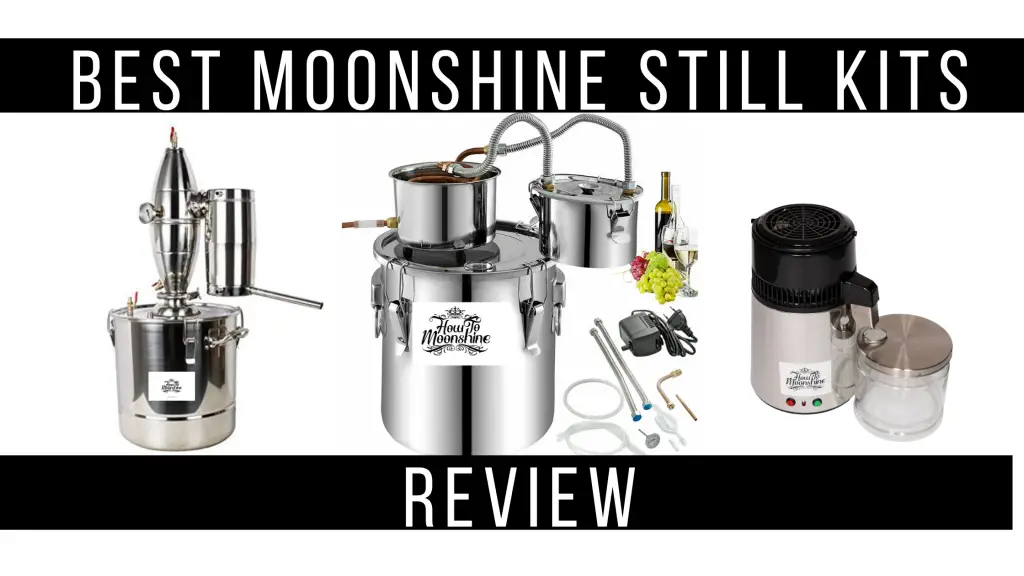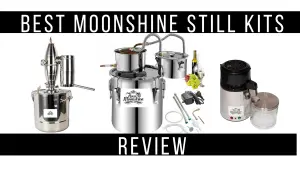Making moonshine can be complicated, but the right still can make it easy! Check out our moonshine still with a heating element.
What is a Moonshine?
A moonshine still is a tool used to distill alcohol, which can be done both in a commercial distillery or from the comfort of home.
While many may only associate moonshine with the prohibition era, this is far from the truth.
In fact, moonshine may have come to the United States with its early American settlers, but the term moonshine goes back to the 15th century in Europe.
With this in mind, moonshine has a long history in the United States that began far earlier than prohibition.
One of the biggest concerns with moonshine, especially during the prohibition era, was with its production. Moonshine stills were homemade often with car parts, specifically the radiator.
What is a Moonshine Still?
The design of a moonshine still typically includes a large pot or kettle for heating the fermented liquid, a condenser to collect the evaporated alcohol, and a cooling system to turn the vapor back into liquid form.
The distillation process involves heating the fermented liquid to create vapor, which is then condensed back into liquid form, resulting in a higher concentration of alcohol.
When using a moonshine still, it is important to consider legal regulations regarding the distillation of alcohol, as in many places it is illegal to produce spirits without the proper licenses and permits.
Additionally, safety precautions must be taken when operating a still, as the heating and distillation process can pose fire hazards and health risks if proper measures are not taken.
Overall, moonshine stills have both historical and modern uses in producing alcohol, but legal and safety considerations must be taken into account when using them.
Check out: How a Moonshine Still Works
Understanding Heating Elements in Moonshine Stills
Moonshine stills have been used for centuries to convert grain, sugar, or fruit into alcoholic spirits, and heating elements play a crucial role in this process.
Understanding the different types of heating elements and how they work is essential for anyone looking to craft their own moonshine.
From electric to gas and steam, the type of heating element used can have a significant impact on the flavor and quality of the final product.
Whether you are a hobbyist or a serious distiller, understanding heating elements in moonshine stills is key to producing a high-quality, great-tasting spirit.
Importance of Heating Elements in the Distillation Process
Heating elements play a crucial role in the distillation process by providing the necessary heat to evaporate the liquid and separate its components.
With advancements in electric heating solutions, distillation processes have become more efficient and precise.
Electric heating elements offer better temperature control, higher energy efficiency, and improved safety compared to traditional heating methods.
At How to Moonshine, we have several moonshine stills with built-in electric heating elements.
The Moonshine Cherry
The Moonshine Cherry is a best seller, likely because of how simple it is to assemble and operate. Get started creating your very own moonshine in as little as two hours.
Its plug-and-play design means your delicious moonshine is just a press of a button away. Plus, its concise size makes it an ideal fit for your kitchen counter.
Unsurprisingly, the Moonshine Cherry Air Still is named after its deep red hue and its capabilities to produce great moonshine. This small, kettle-like device offers a hassle-free moonshine-making experience.
This air still is electric with an internal fan for cooling. This means there is no need for an external water source, which simplifies the entire process.
By using an electric air still, you can simply set the temperature and start distilling. It really could not be any simpler.
The Standard

The Standard is a great option for anyone who wants a great quality shine with less effort. The Standard is a quality column still, which are known for creating delicious spirits with a high ABV. With its built-in electric heater, The Standard can be easily set to its ideal temperature.
Take advantage of the built-in electric heating system for automated temperature management. Just set it and let the still do its magic!
And with the convenient drain spout for easy drainage, making shine is easier than ever.
The White Lightning 8 Gallon Moonshine Pot Still

The White Lightning 8 Gallon Moonshine Pot Still is a great option for anyone who wants a pot still with a convenient external electric heating band.
By using an electric heating band you can have control over your heat easily while using our best-selling 8 gallon moonshine still.
Expertly made with top-notch materials, this pot still is created for effortless use and assembly.
How to Choose Your Heating Element
When choosing the right heating element size, it is important to consider the volume and composition of the liquid being distilled, as well as the desired rate of evaporation.
The port location of the heating element also impacts the efficiency of the distillation process, as it affects the distribution of heat throughout the liquid.
Additionally, the liquid levels in the distillation apparatus play a significant role in the process. Proper liquid levels ensure that the heating elements are in contact with the liquid, allowing for efficient heat transfer and evaporation. Maintaining the correct liquid levels also prevents overheating or incomplete distillation.
Heating elements are essential for the distillation process, and advancements in electric heating solutions have improved its efficiency and precision. It is important to consider the right element size and port location, as well as to monitor liquid levels to ensure a successful distillation process.
Different Types of Heating Elements Commonly Used
Internal heating elements are commonly used in distilling equipment and are located inside the still. They provide even heat distribution and are ideal for smaller-scale distillation processes.
However, they may be difficult to clean and maintain.
Hot plates are another popular heating element for distilling. They are portable and can be easily adjusted for temperature control. However, they may not provide as even heat distribution as internal elements and can be a potential fire hazard if not monitored carefully.
Steam jackets work by circulating steam through a jacket surrounding the distillation vessel. They provide precise temperature control and are suitable for larger-scale distillation processes. However, they require a separate boiler or steam source, which adds to the overall cost and complexity of the setup.
Potential risks or issues that may arise during the distillation process with these heating elements include overheating, uneven heat distribution leading to inconsistent results, and the risk of fire if not properly monitored. It is essential to carefully follow safety protocols and regularly maintain and inspect the heating elements to ensure a safe and effective distillation process.
Factors to Consider when Choosing a Heating Element for a Moonshine Still
When setting up a moonshine still, choosing the right heating element is crucial for the overall functionality and safety of the device.
Factors such as the type of distillation setup, the power source, the size of the still, and the materials being used all play important roles in determining the most suitable heating element for the job.
Understanding these factors can help ensure that the heating element chosen for the moonshine still is efficient, reliable, and meets the specific needs of the distillation process. By considering these factors carefully, distillers can make an informed decision when selecting a heating element that will contribute to the success of their moonshine production.
Watt density and its impact on efficiency
Watt density, or the amount of power applied per unit area of a heating element, directly impacts the efficiency of a heating system. The relationship between watt density and efficiency lies in the balance between heat generation and energy consumption.
If the watt density is too low, the system may not generate enough heat for the application, leading to inefficiency.
On the other hand, if the watt density is too high, it can result in excessive energy consumption and reduced system efficiency.
Several key factors influence the optimal watt density for different applications, including the type of material being heated, the operating temperature, and the design of the heating element.
For example, high watt density is suitable for materials with high thermal conductivity, while low watt density may be preferred for temperature-sensitive materials.
Proper selection of watt density is crucial for maximizing efficiency and overall system performance. By selecting the right watt density, the system can operate at its optimal efficiency, leading to energy savings and prolonged system longevity. In conclusion, watt density plays a critical role in the efficiency of heating systems and must be carefully considered for each application.
Electric options vs. other heating methods
Advantages of electric heating for stills include precise temperature control, ease of installation and no need for a flue or ventilation system. Users have reported that electric heating allows for better temperature management, resulting in higher quality distillates. Additionally, electric heating is often more energy efficient and cost effective in the long run.
However, there are also some disadvantages compared to other heating methods. Gas heating, for example, is often faster and more powerful, making it more suitable for larger stills. Steam jacket heating is also popular for its even distribution of heat. Some users have experienced longer heating times with electric options, which can be a downside in a production setting.
In comparison to gas and steam jacket heating, electric options are also typically easier to maintain and require less frequent servicing. While gas and steam jacket heating may offer quicker heating times, the precise temperature control and energy efficiency of electric heating make it a popular choice for smaller scale distilleries or home distillers. Ultimately, the best heating method for stills will depend on the specific needs and preferences of the user.
Types of Heating Elements for Moonshine Stills
When it comes to moonshine stills, the type of heating element chosen can significantly impact the quality of the final product. There are various types of heating elements available, each with its own set of advantages and disadvantages. Understanding the different types of heating elements for moonshine stills is crucial for a successful and efficient distillation process. Whether it’s an electric, gas, or wood-fired heating element, each option has its own unique qualities and considerations that can affect the overall outcome of the distillation process. Let’s explore the various types of heating elements for moonshine stills and their respective characteristics to help you make an informed decision for your distilling needs.
Stainless steel cartridge heaters and their benefits
Stainless steel cartridge heaters offer several benefits when used in distillers and moonshine stills. These heaters are designed to provide uniform heat distribution, which is essential for successful distillation processes. The stainless steel construction makes them durable and resistant to corrosion, ensuring a long lifespan for the heaters. Additionally, they are compatible with the Mile Hi Distilling Temperature Controller, allowing for precise temperature control during the distillation process.
These heaters are essential for maintaining the optimal temperature required for distillation, ultimately leading to high-quality and consistent results. The use of stainless steel cartridge heaters in moonshine stills and distillers ensures that the liquid is heated evenly, promoting efficient vaporization and separation of components.
Furthermore, each stainless steel cartridge heater comes with one Teflon Washer, which helps to create a tight seal and prevent leakage. This additional component adds to the overall reliability of the heaters and contributes to the successful operation of the distillation equipment.
In conclusion, stainless steel cartridge heaters are a crucial component for achieving the desired results in distillation processes, and their compatibility with Mile Hi Distilling Temperature Controller makes them a valuable asset for any distiller or moonshine still owner.
Screw-in type elements and their advantages
Screw-in elements are commonly used in heating appliances such as water heaters and electric ovens. There are several types of screw-in elements, including the standard straight or curved shape, as well as flanged and low-watt density elements. These elements are typically made of materials such as copper, steel, or stainless steel to withstand high temperatures and resist corrosion.
To install screw-in elements, the old element is unscrewed and removed, and then the new element is screwed into place using a wrench or pliers. Once installed, the electrical connections are attached to complete the installation.
The advantages of screw-in elements over other types of heating elements include easy installation and replacement, as well as the ability to customize the size and shape of the element to fit specific heating appliance requirements. Additionally, screw-in elements can be easily removed for cleaning or maintenance, making them a convenient and efficient choice for heating appliances such as electric ovens.
Installation and Replacement of Heating Elements in Moonshine Stills
Moonshine stills are essential tools for anyone looking to produce homemade spirits. However, over time, the heating elements in these stills may wear out or become damaged, requiring installation or replacement. Properly maintaining these components is crucial to ensuring the safe and effective operation of the still, as well as the quality of the final product. From understanding the different types of heating elements to knowing when it’s time for replacement, this guide will provide essential information for anyone looking to maintain their moonshine still.
Proper installation techniques for heating elements
Electric heating elements offer safety and efficiency benefits in moonshine stills. To install them properly, first, ensure the still is turned off and the heating element is cool. Then, carefully select a location within the still where the heating element can be securely attached, ensuring it will be fully submerged in the liquid during operation. Use a waterproof sealant to secure the element in place and prevent any leaks. Next, connect the wiring according to the manufacturer’s instructions, making sure all connections are tight and secure. Test the element to ensure it heats properly before using it for distillation.
To avoid hazards, always follow proper electrical safety precautions during installation, such as ensuring the still is grounded and using waterproof wiring. Additionally, regularly inspect the heating element for any signs of wear or damage and replace it if needed. By following these installation techniques, the electric heating element in your moonshine still can provide safe and efficient heating for your distillation process.
Steps for replacing a faulty or damaged element
- Identify the faulty or damaged part and gather the necessary tools for the replacement process, such as screwdrivers, pliers, and safety equipment.
- Refer to the manufacturer’s instructions or guidelines to ensure the proper replacement process and to determine if any specific steps or precautions need to be followed.
- Carefully remove the old part, taking note of how it is installed and any specific connections or attachments that need to be addressed.
- Install the new part, following the manufacturer’s instructions and guidelines to ensure proper installation and function.
- Double-check all connections and ensure that the new part is securely in place before testing the element to ensure it is working correctly.
- Dispose of the old part properly, and clean up any debris or tools used during the replacement process.
By following these steps and being mindful of the specific manufacturer’s instructions, the replacement of a damaged or faulty element can be completed efficiently and effectively, ensuring the proper functioning of the equipment or appliance.
Safety Considerations with Heating Elements in Moonshine Stills
When it comes to operating moonshine stills, safety is of the utmost importance, especially when dealing with heating elements. Whether you are building your own still or using a commercial one, understanding and implementing safety considerations with heating elements is crucial to prevent accidents and ensure a smooth and successful distillation process. From proper insulation to ventilation and using the right type of heat source, there are several factors to consider when it comes to staying safe while using heating elements in moonshine stills. Let’s take a closer look at some key safety considerations to keep in mind.
Importance of using the correct wattage and voltage
Using the incorrect wattage and voltage when operating electrical devices can pose serious dangers. It is crucial to follow the manufacturer’s specifications to ensure the safety and proper functioning of the device. Common household appliances such as refrigerators, washing machines, and air conditioners typically require higher wattage and specific voltage to operate efficiently. Small electronic devices like laptops, smartphones, and chargers have lower wattage and voltage requirements.
Using the wrong wattage or voltage can lead to damage to the device, electrical fires, or electric shock. For example, using a higher wattage or voltage than specified can cause the device to overheat and potentially catch fire. On the other hand, using a lower wattage or voltage can lead to the device not functioning properly and potentially causing a short circuit.
It is essential to pay attention to the wattage and voltage requirements of each electrical device, and to always use the correct power source. By following the manufacturer’s specifications, you can ensure the safety of the device, prevent potential hazards, and prolong the lifespan of the electrical equipment.





